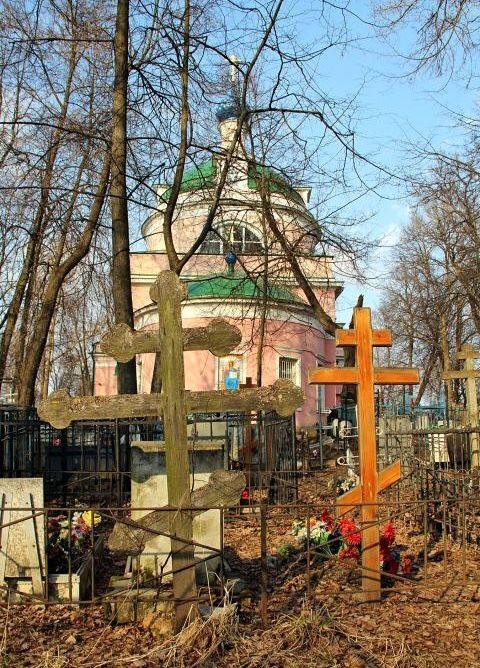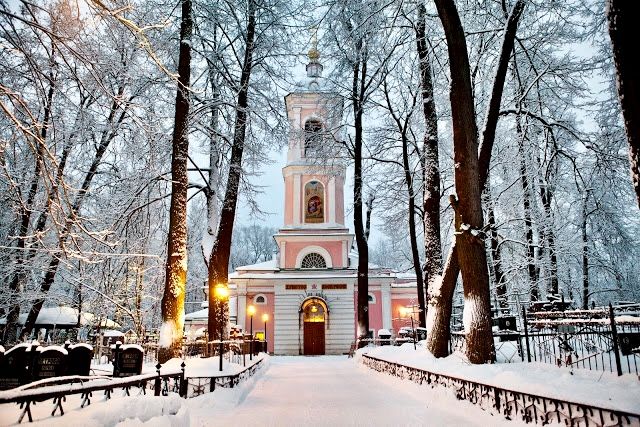| Description |
: |
Cemetery is adjacent to Church of Nativity and overgrown from a traditional church graveyard.
A stone church in honor of the Nativity of Christ in the village of Zaozyoriye was built in 1809 instead of the wooden one by the painstaking efforts of the local landowner Gavriil Vasilyevich Ryumin. The aisles were arranged in the church in a warm refectory in the name of St. Tikhon of Amafunta and St. Nicholas of Myra.
The high elegant structure of the church in the classicist style, after the Moscow fire of 1812, did not accommodate the increased population of the Moscow Region and...
Read More
|
Cemetery is adjacent to Church of Nativity and overgrown from a traditional church graveyard.
A stone church in honor of the Nativity of Christ in the village of Zaozyoriye was built in 1809 instead of the wooden one by the painstaking efforts of the local landowner Gavriil Vasilyevich Ryumin. The aisles were arranged in the church in a warm refectory in the name of St. Tikhon of Amafunta and St. Nicholas of Myra.
The high elegant structure of the church in the classicist style, after the Moscow fire of 1812, did not accommodate the increased population of the Moscow Region and the surrounding provinces. In January 1854 priest Andrey Rumyantsev, with clergy and parishioners submitted a humble petition "about the spread of the spiritual meal."
The main funds for the rebuilding of the church were donated by a real state councilor, chamberlain Nikolay Gavrilovich Ryumin. Managing his estate, the third guild merchant Platon Mikhaylov donated forty thousand bricks and wood for this building.
The central iconostasis was created in 1809 in the same style as the church. The iconostases of the chapels were made in the 1890s in the spirit of eclecticism. Then artist Afanasyev painted walls and ceilings in a late academic manner. The installation of gilded iconostases of the aisles, as well as the painting of walls and ceiling shades, was carried out mainly at the expense of the churchwarden S.I. Baranov and his son-in-law Moscow merchant F.E.Baranov.
In Soviet times there were attempts to transfer church to the local council for household needs, but parishioners did not allow it.
Among the particularly revered icons, one can note the image of the Monk Sergius of Radonezh in full growth on a gilt carved gesso, located in the Nikolskiy aisle. The image of the Monk Seraphim of Sarov with a part of the stone on which the monk was praying, and part of his mantle, is especially loved by parishioners.
Icon of the holy noble prince Alexander Nevsky in a beautiful black and gold icon case is specially honored and was created by order and at the expense of parishioners in memory of the murdered emperor Alexander II. Beautiful three-light hanging chandelier made from gilded carved copper, decorated with the royal emblem, has the inscription on the lace wings: "In memory of the birth of the Heir Alexey Tsesarevich. July 30, 1904 ”is also a gift of parishioners.
In April 1913, a society of gonfalonians was opened at the church.
Today, the maintenance of the temple is carried out with the help of donors, as in the past. A few years ago, the temple was presented with nine bells. In 2001, philanthropists acquired a bell of 1000 kg, thanks to which the belfry acquired a remarkably beautiful sound.
The most attended holiday of the parish is Tikhon Day, a memorial day for St. Tikhon of Amafunta. This is not only a church holiday, but a celebration of the entire area. Previously, because of the crowded days, fairs were held in the days of the holiday in Zaozyoriye. |





